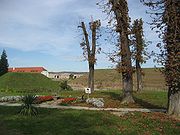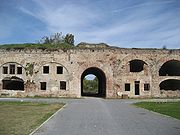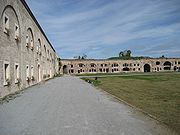
The Brod Fortress
Encyclopedia




The cultural heritage of highest importance (0-category).
History
The city of Slavonski BrodSlavonski Brod
Slavonski Brod is a city in Croatia, with a population of 59,507 in 2011. The city was known as Marsonia in the Roman Empire, and as Brod na Savi 1244–1934. It is the sixth largest city in Croatia, after Zagreb, Split, Rijeka, Osijek and Zadar. Located in the region of Slavonia, it is the...
, Croatia
Croatia
Croatia , officially the Republic of Croatia , is a unitary democratic parliamentary republic in Europe at the crossroads of the Mitteleuropa, the Balkans, and the Mediterranean. Its capital and largest city is Zagreb. The country is divided into 20 counties and the city of Zagreb. Croatia covers ...
, which was an important strategic and traffic center controlling the border crossing towards Turkey
Turkey
Turkey , known officially as the Republic of Turkey , is a Eurasian country located in Western Asia and in East Thrace in Southeastern Europe...
and connecting main commercial trails at the time, in the period between 1715-1780 Austria
Austria
Austria , officially the Republic of Austria , is a landlocked country of roughly 8.4 million people in Central Europe. It is bordered by the Czech Republic and Germany to the north, Slovakia and Hungary to the east, Slovenia and Italy to the south, and Switzerland and Liechtenstein to the...
built the large imperial and royal border Fortress of Brod on the Sava River
Sava River
The Sava is a river in Southeast Europe, a right side tributary of the Danube river at Belgrade. Counting from Zelenci, the source of Sava Dolinka, it is long and drains of surface area. It flows through Slovenia, Croatia, along the northern border of Bosnia and Herzegovina, and through Serbia....
, which along with the fortified baroque
Baroque
The Baroque is a period and the style that used exaggerated motion and clear, easily interpreted detail to produce drama, tension, exuberance, and grandeur in sculpture, painting, literature, dance, and music...
towns of Slavonia
Slavonia
Slavonia is a geographical and historical region in eastern Croatia...
, namely Osijek
Osijek
Osijek is the fourth largest city in Croatia with a population of 83,496 in 2011. It is the largest city and the economic and cultural centre of the eastern Croatian region of Slavonia, as well as the administrative centre of Osijek-Baranja county...
and Stara Gradiška, belongs to the great defense system on the border towards the Turkish Empire, designed by the prince Eugene of Savoy
Prince Eugene of Savoy
Prince Eugene of Savoy , was one of the most successful military commanders in modern European history, rising to the highest offices of state at the Imperial court in Vienna. Born in Paris to aristocratic Italian parents, Eugene grew up around the French court of King Louis XIV...
in the first half of the 18 century. It was constructed by peasants of the Military Border under forced labor more specifically 634 a day, who also gave 53 horse-drawn carts daily for the transport of material. The regular star-like form of the fortress was determined by the flat-country. It was built of rammed earth, bricks, wood and partially stone, and designed for the accommodation of 4.000 soldiers, mostly infantry and 150 cannons.
According to an evaluation of the Brod Fortress resistance, during the classical siege with full capacity channels, it would have taken ten days of preparation for the attacks and 46 days for the enemy to take over the entire Fortress. The Fortress of Brod occupied about 33 ha. The military government did not allow for the construction of solid material houses, because the entire town was within the range of the fortress cannons, and consequently, throughout the entire 18 and most of the 19 century, Brod was the town of small wooden houses, roofed by shingle or board. In case of the potential Turkish attack, the town was to be leveled down, in order to provide the artillery with the open space around the fortress. Although being a military border stronghold, the Fortress almost never had the opportunity to prove and demonstrate its combative power. However, there are many preserved fortifications reminiscent of the bygone times and the everyday military life that took place within. The Fortress of Brod was constructed according the Vauban
Vauban
Sébastien Le Prestre, Seigneur de Vauban and later Marquis de Vauban , commonly referred to as Vauban, was a Marshal of France and the foremost military engineer of his age, famed for his skill in both designing fortifications and breaking through them...
system. It is basically of a rectangular form, while the system of defense channels provides its star-like layout. It consisted of three defense zones: internal, external and southern, and it was protected by two moat areas, water-fed from the nearby stream.
The southern part
The southern part of the Fortress was specially reinforced by the fortification named Hornwerk, because of its horn-like layout (germ. Horn-horn). The principal task of Hornwerk was to obstruct the Turkish crossings over the Sava River by implementation of cannons. However, by the end of the 18th century, within the southern defense zone several constructions were erected, such as the Fortress Commander building which today houses The Ivan ZajcIvan Zajc
Ivan Dragutin Stjepan Zajc or Ivan pl. Zajc , was a Croatian composer, conductor, director and teacher who for over forty years dominated Croatia's musical culture...
Elementary School of Music, Officers' Pavilion, which apart from the officers' apartments and which today houses the City Government Headquarters, the Fortress Chaplain apartment (today here is The Tourist Information Center of Tourist Board), the Commander's kitchen, the cart-wright's and stables, while the remaining free areas were used for orchards, gardens and parks.
The internal part
The internal central part of the Fortress is rectangular in shape and consists of four bastions connected by defensive walls. The bastions - pentagonal rammed earth bulwarks brick walled from the outside were organized for the final resistance against the enemies, and were used to monitor the area in front of the Fortress, defend the external walls and the neighboring bastion. Apart from 46 cm high cannon platforms, up to 4 sentry boxes were placed on each bastion for defense purposes. There are curtain walls - the main walls connecting each two bastions. They were brick-built, with a clay overlayer on the top side for the defense path. In the curtain wall interior there are rooms for accommodation of men and ammunition, as well as the workshops required for the Fortress functioning, with passages across the middle. Nowadays, in the reconstructed forge room in the west curtain wall, visitors of the Fortress can meet the Fortress blacksmithBlacksmith
A blacksmith is a person who creates objects from wrought iron or steel by forging the metal; that is, by using tools to hammer, bend, and cut...
.
The central part
Within the central part there is the CavalierCavalier (fortification)
The term Cavalier has been adopted from the French as a term in fortification for a work of great height constructed in the interior of a fort, bastion or other defence, so as to fire over the main parapet without interfering with the fire of the latter. A greater volume of fire can thus be...
- a massive brick-walled one-storey construction in the form of the horse-shoe. In the Cavalier interior there were up to 108 large rooms of identical dimensions - casemates, used for the army logistic purposes, namely for the accommodation of the soldiers, artillery workshops, cart-wright's, locksmith's, armorer's shop, armory, bakery, storage, hospital, pharmacy.
Today, the renovated part of the southwestern tract of the Cavalier, on the gross area of 1.800 sq. m, houses the unique Ružić Gallery with the first permanent exhibition of the Croatian modern art of the second half of the 20 century. More than 400 works of art from the collection of the Croatian
Croats
Croats are a South Slavic ethnic group mostly living in Croatia, Bosnia and Herzegovina and nearby countries. There are around 4 million Croats living inside Croatia and up to 4.5 million throughout the rest of the world. Responding to political, social and economic pressure, many Croats have...
sculptor and painter, Branko Ružić, born in Brod (Slavonski Brod, 1919 - Zagreb
Zagreb
Zagreb is the capital and the largest city of the Republic of Croatia. It is in the northwest of the country, along the Sava river, at the southern slopes of the Medvednica mountain. Zagreb lies at an elevation of approximately above sea level. According to the last official census, Zagreb's city...
, 1997), as well as his contemporaries and friends are at display in the Gallery. Until 1947, there was a baroque Fortress church of St. Ann at the center of the Fortress square, protected by two buildings on the south side - the Slavonian barracks, renovated and today housing the classical program high school of Father Marijan Lasković and the Headquarters barracks. The organized tourist groups, previously announced at the Tourist Board, have the opportunity to attend the "living history" programs at the Fortress square, featuring individuals dressed as hussars of the 12 Slavonian hussar
Hussar
Hussar refers to a number of types of light cavalry which originated in Hungary in the 14th century, tracing its roots from Serbian medieval cavalry tradition, brought to Hungary in the course of the Serb migrations, which began in the late 14th century....
regiment from the second half of 18 century, as well as the other characters from the Fortress past such as the Fortress Commander and the Fortress clerk, the Fortress guards and craftsmen etc.
The external defence zone
The external defense zone consisted of ravelins - triangular bastions protecting the main walls and obstructing the enemy access to the Fortress. All ravelins are constructed of rammed earth and brick walled on the outside, while in the upper part there is an overlayer and parapets. Within the west and east ravelin walls there is a redoubt - the pentagonal fortification used as a provisional powder magazine and as a gunsmith's. Due to the rapid development of the siege techniques, the Brod Fortress lost its defensive task already by the mid 19th century. From that point onwards, Brod on the Sava River started its intensive development, while the old wooden Brod started to disappear. The devastation of the Brod Fortress continues throughout the 20th century. Some objects were destructed by the army as useless, while the abandoned and unsustainable buildings cave in and dilapidate. In the period from 1945 up until the Croatian War of IndependenceCroatian War of Independence
The Croatian War of Independence was fought from 1991 to 1995 between forces loyal to the government of Croatia—which had declared independence from the Socialist Federal Republic of Yugoslavia —and the Serb-controlled Yugoslav People's Army and local Serb forces, with the JNA ending its combat...
in the '90s, the Fortress serves as accommodation for the soldiers of the National Army of Yugoslavia. Today the Fortress of Brod, cultural heritage site and the unique and monumental example of the 18th century Slavonian military fortification architecture, belongs to the city of Slavonski Brod
Slavonski Brod
Slavonski Brod is a city in Croatia, with a population of 59,507 in 2011. The city was known as Marsonia in the Roman Empire, and as Brod na Savi 1244–1934. It is the sixth largest city in Croatia, after Zagreb, Split, Rijeka, Osijek and Zadar. Located in the region of Slavonia, it is the...
, decidedly initiating its revitalization.

